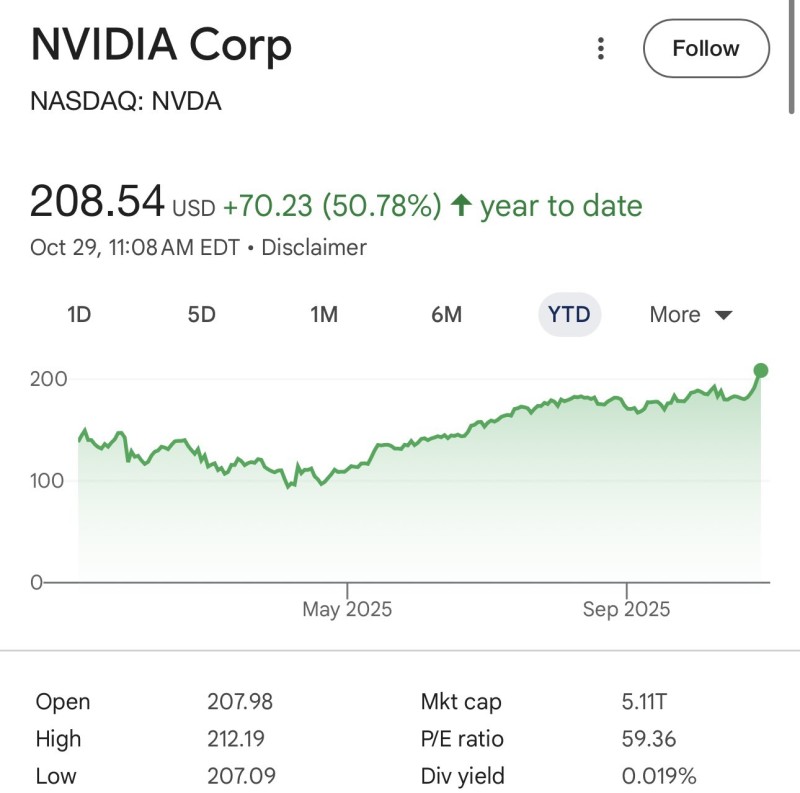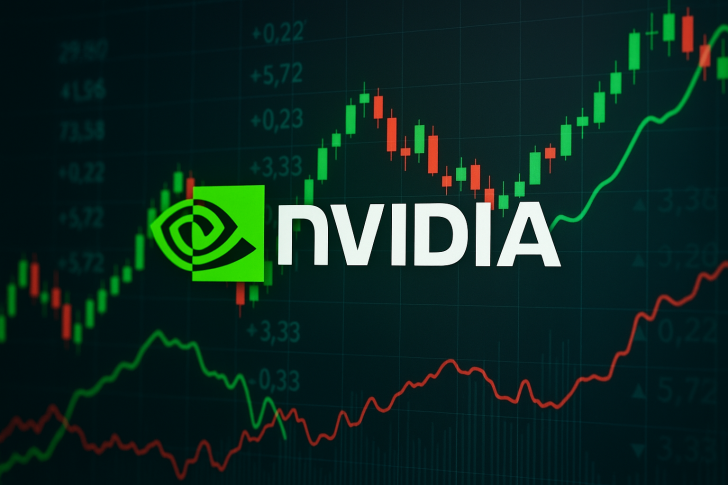The AI boom has fundamentally reshaped global markets, and no company illustrates this better than NVIDIA ($NVDA). The chipmaker has hit a $5.11 trillion market capitalization—a figure that equals 16% of the entire U.S. GDP. What was once a niche graphics card company has become a macroeconomic powerhouse, driving productivity, investment, and innovation in what many are calling the AI industrial era.
NVIDIA Stock Hits Record Highs
A chart shared by Shay Boloor highlights this remarkable milestone: a smooth, nearly unbroken climb through 2025 that has solidified NVIDIA's status as the most systemically important company in tech.

On October 29, 2025, NVIDIA shares closed at $208.54—up 50.78% year-to-date. The company's market cap reached $5.11 trillion, with a P/E ratio of 59.36, reflecting strong investor confidence despite high valuations.
- Open: $207.98
- High: $212.19
- Low: $207.09
- Dividend yield: 0.019%
This surge caps a decade-long transformation from gaming hardware maker to the defining enterprise of the AI economy.
Chart Analysis: Steady Uptrend and Breakout
The chart shows a disciplined, consistent uptrend throughout 2025. NVIDIA broke above the $200 resistance zone in late October, hitting a new all-time high. The smooth upward trajectory suggests sustained institutional buying rather than speculative hype. With no sharp corrections, the price action reflects a mature bull run backed by solid fundamentals. The breakout coincides with NVIDIA crossing the $5 trillion threshold—one of the most valuable milestones in corporate history.
At $5.11 trillion, NVIDIA now represents 16% of U.S. GDP, which sits near $32 trillion. To put that in perspective: one company equals one-sixth of the American economy. NVIDIA's valuation exceeds the entire GDP of Japan or Germany, and its 2025 gains alone surpass the annual economic output of several developed nations. This makes NVIDIA not just a market leader, but a macroeconomic phenomenon influencing everything from capital spending to AI policy.
Why NVIDIA's Rise Is Unmatched
AI as the core of global growth: NVIDIA's GPUs power most AI systems—from ChatGPT to Tesla's autonomous software. The company's hardware has become the infrastructure of digital intelligence, earning it the same strategic importance oil had in the industrial age.
Data centers fueling revenue: NVIDIA's data center division has overtaken gaming as its main revenue driver, with demand surging from Microsoft, Amazon, Google, and AI startups worldwide. Analysts expect another 40–50% revenue jump in fiscal 2026.
Software ecosystem advantage: Beyond chips, NVIDIA's CUDA platform and AI development tools create deep vendor lock-in that competitors like AMD and Intel struggle to match. This turns one-time hardware buyers into long-term software partners.
Market psychology: NVIDIA has become the proxy for the AI economy. Institutional investors now treat it as a benchmark for the sector's health—a role Apple and Microsoft played in previous decades.
The concentration of so much capital in one stock has serious implications. NVIDIA's valuation alone can move the S&P 500 and shape national investment trends. Policymakers now view AI compute capacity—most of it powered by NVIDIA—as strategic infrastructure, not just a corporate product. And with NVIDIA representing such a huge slice of U.S. market cap, any slowdown could send ripples across the entire economy. This convergence of corporate value and national output is unprecedented, marking the start of AI-driven macroeconomics.
 Artem Voloskovets
Artem Voloskovets

 Artem Voloskovets
Artem Voloskovets


